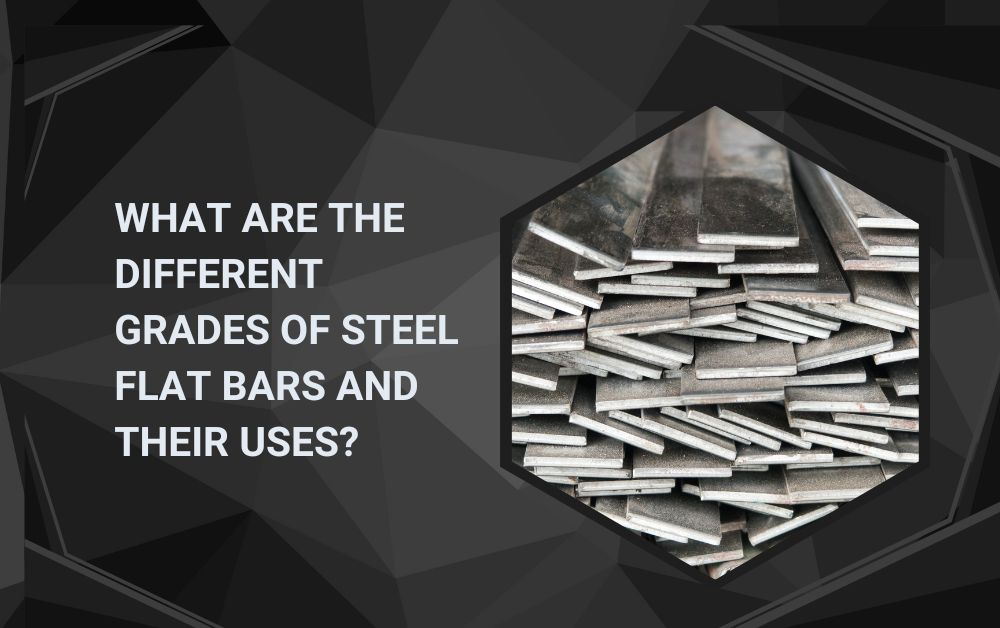Steel flat bars are versatile materials used in various industries for different applications. Understanding the different grades of steel flat bars and their uses is essential for making the right choice for your projects. In this blog post, we’ll explore the different grades of steel flat bars, their properties, and their common uses.

What is a Steel Flat Bar?
Definition of Steel Flat Bars
Steel flat bars are long, flat pieces of steel with a rectangular cross-section. They are commonly used in construction, manufacturing, and other industries due to their strength and versatility.
Common Sizes and Shapes
Steel flat bars come in various sizes and thicknesses. They can be cut to specific lengths and widths based on the requirements of a project. Typical sizes range from small bars that are just a few millimeters thick to larger ones that are several centimeters thick.
NOTE:- Whether you’re tackling a construction job, manufacturing parts, or working on a DIY project, selecting the right steel flat bar is crucial. Contact us today to explore our wide range of steel flat bars and get expert advice tailored to your needs. Don’t settle for less—choose quality steel flat bars that deliver strength and durability! Reach out now and ensure your project is built to last.
Different Grades of Steel Flat Bars
Steel flat bars are classified into different grades based on their chemical composition and mechanical properties. Each grade has specific characteristics that make it suitable for various applications.
Carbon Steel Grades
Carbon steel is one of the most common types of steel used for flat bars. It is classified into three main grades: low carbon, medium carbon, and high carbon steel.
Low Carbon Steel (Grade A36)
- Properties: Low carbon steel, also known as mild steel, contains a small amount of carbon, usually less than 0.3%. This makes it relatively soft and easy to shape.
- Uses: It is widely used in construction and manufacturing for structural purposes, such as beams and frames. It’s also used in the automotive industry and for making machinery parts.
Medium Carbon Steel (Grade 1045)
- Properties: Medium carbon steel contains more carbon than low carbon steel, typically between 0.3% and 0.6%. It is stronger and more durable but can be harder to machine.
- Uses: This grade is used for making parts that require higher strength and toughness, such as gears, shafts, and structural components.
High Carbon Steel (Grade 1095)
- Properties: High carbon steel has a high carbon content, usually between 0.6% and 1.0%. It is very hard and strong but can be brittle.
- Uses: It is used for tools and knives, as well as in applications where high wear resistance is needed, such as in springs and high-stress components.
Alloy Steel Grades
Alloy steel contains additional elements like chromium, nickel, or molybdenum, which enhance its properties.
Low Alloy Steel (Grade 4140)
- Properties: Low alloy steel contains small amounts of elements like chromium and molybdenum. It offers improved strength and hardness compared to carbon steel.
- Uses: It is used in applications that require high strength and impact resistance, such as in machinery, automotive parts, and structural components.
High Alloy Steel (Grade 4340)
- Properties: High alloy steel contains higher amounts of alloying elements like nickel and chromium. It provides excellent toughness and resistance to wear and fatigue.
- Uses: This grade is used in high-performance applications, such as aerospace components, heavy machinery, and parts subjected to extreme conditions.
Stainless Steel Grades
Stainless steel is known for its resistance to corrosion and staining. It is available in various grades, including:
Austenitic Stainless Steel (Grade 304)
- Properties: Austenitic stainless steel contains chromium and nickel, which provide excellent corrosion resistance and good machinability.
- Uses: It is commonly used in kitchen appliances, medical instruments, and architectural applications due to its resistance to rust and easy maintenance.
Ferritic Stainless Steel (Grade 430)
- Properties: Ferritic stainless steel contains chromium but little or no nickel. It offers good resistance to oxidation and corrosion but is less ductile than austenitic grades.
- Uses: It is used in automotive parts, appliances, and industrial equipment where moderate corrosion resistance is required.
Martensitic Stainless Steel (Grade 410)
- Properties: Martensitic stainless steel contains chromium and is known for its high hardness and strength. It is less resistant to corrosion compared to austenitic and ferritic grades.
- Uses: It is used in applications that require high strength and wear resistance, such as cutlery, tools, and valves.
How to Choose the Right Grade for Your Project
Selecting the appropriate grade of steel flat bar depends on several factors, including:
1. Strength Requirements
Determine the strength needed for your application. For example, if you need high tensile strength, high carbon or alloy steel might be more suitable.
2. Corrosion Resistance
Consider the environment in which the steel will be used. Stainless steel grades are ideal for environments prone to corrosion.
3. Machinability
If the steel will be machined or welded, choose a grade that offers good machinability. For instance, low carbon steel is easier to work with compared to high carbon steel.
4. Cost
Higher-grade steels often come with a higher price tag. Balance your requirements with your budget to make the best choice.
Common Applications of Steel Flat Bars
Steel flat bars are used in various applications across different industries. Here are some common uses:
Construction
- Structural Components: Used in beams, columns, and frames for buildings and bridges.
- Reinforcement: Often used as reinforcement bars in concrete structures.
Manufacturing
- Machinery Parts: Used to make parts such as gears, shafts, and brackets.
- Automotive: Used in the production of car parts and frames.
Home and DIY Projects
- Furniture: Commonly used to make custom furniture pieces and fixtures.
- Home Repairs: Useful for various repair tasks around the home, such as creating brackets or supports.
Conclusion
Choosing the right grade of steel flat bars is essential for ensuring the success of your project, whether it’s in construction, manufacturing, or a DIY endeavor. Each grade of steel offers specific properties that make it suitable for various applications, from the versatile and cost-effective low carbon steel to the highly durable and corrosion-resistant stainless steel.
For more insightful articles related to this topic, feel free to visit thataiblog.com




